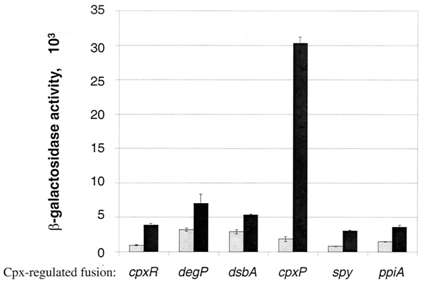Team:Calgary/Project/CpxP
From 2010.igem.org
Pauladamiak (Talk | contribs) |
H.dastidar (Talk | contribs) |
||
| Line 90: | Line 90: | ||
<br/> | <br/> | ||
<h2 style="color:#0066CC">What causes periplasmic stress?</h2> | <h2 style="color:#0066CC">What causes periplasmic stress?</h2> | ||
| + | |||
| + | <p> Periplasmic stress, also known as envelope stress, is triggered by several factors that influence the ability of the bacteria to communicate with other cells through quorum sensing, pathological pathway, pili formation, outer membrane protein formation which plays a role in adhesion of the cells allowing them to form proper colonies and survive. Many stresses in the periplasmic region are triggered by improper formation of outer protein structures such as pili and lipoprotein disruption that reduces pathogenicity of the bacteria.</p> | ||
<h2 style="color:#0066CC">Team Calgary circuits for periplasmic stress detector</h2> | <h2 style="color:#0066CC">Team Calgary circuits for periplasmic stress detector</h2> | ||
Revision as of 19:00, 27 October 2010

Periplasmic Stress Detectors
What causes periplasmic stress?
Periplasmic stress, also known as envelope stress, is triggered by several factors that influence the ability of the bacteria to communicate with other cells through quorum sensing, pathological pathway, pili formation, outer membrane protein formation which plays a role in adhesion of the cells allowing them to form proper colonies and survive. Many stresses in the periplasmic region are triggered by improper formation of outer protein structures such as pili and lipoprotein disruption that reduces pathogenicity of the bacteria.
Team Calgary circuits for periplasmic stress detector



|
These images illustrate the promoters of choice by team Calgary for detection of periplasmic stress. The promoters of choice include CpxP, CpxR and DegP promoters. |
How does a native E. coli cell combat periplasmic stress?
CpxP
CpxR
DegP
Circuit usage and sensitivity
The circuit that will be constructed to detect protein misfolding will have the cpxP promoter. Two other similar circuits will be constructed to compare the activation of cpxP promoter compared to degP and cpxR promoter. All three promoters have the same function: activation of degP which degenerates misfolded proteins in the cell. As it can be seen in the graph below, the cpxP promoter is the most sensitive to the stress. The purpose of this circuit is to detect protein misfolding. For example, cpxP promoter becomes activated under several specific streses: elevation of pH and overexpression envelope proteins such as NlpE. Hence, if periplasmic misfolding occurs in the cell of an E.coli bacteria, the reporter gene, in this case the Red Fluroscent Protein (RFP), will be activated. Hence, the activation of the RFP will be the indication of a periplasmic protein misfolding.
 "
"
